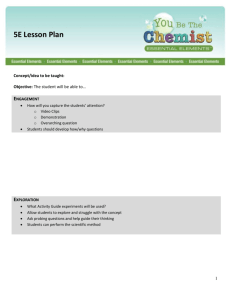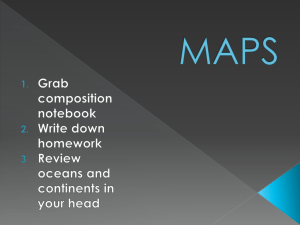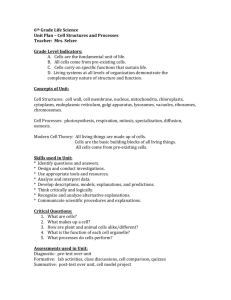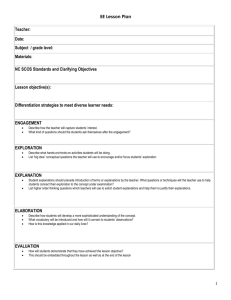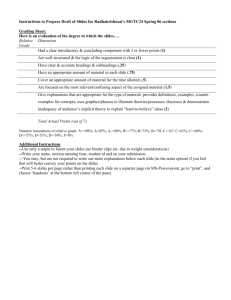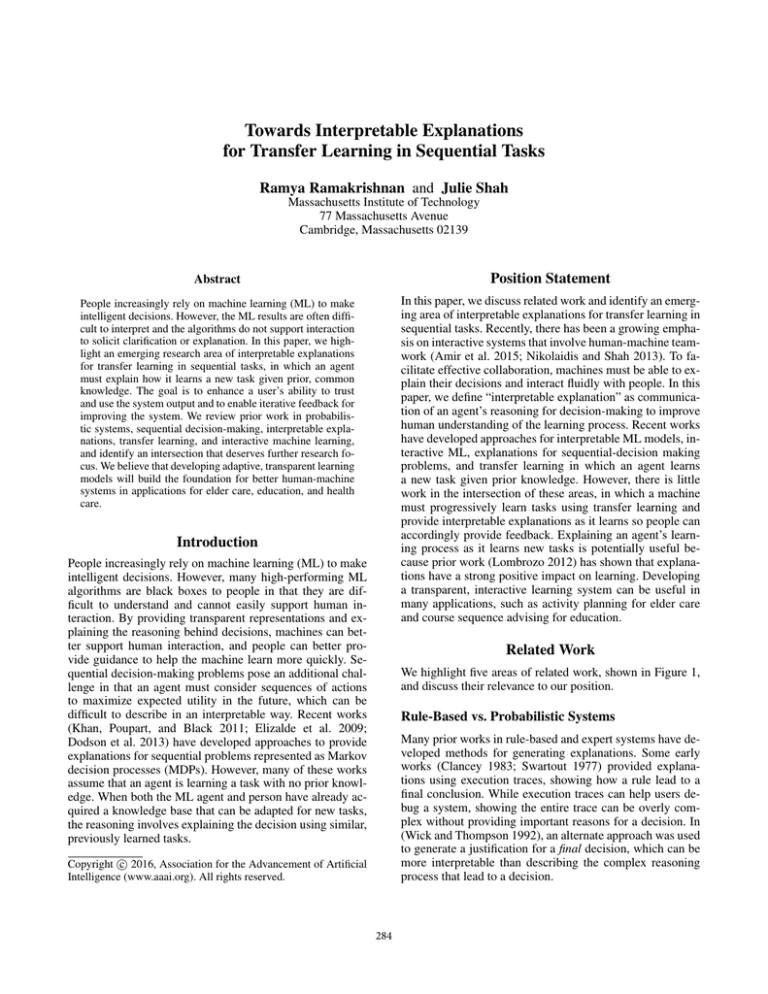
Towards Interpretable Explanations
for Transfer Learning in Sequential Tasks
Ramya Ramakrishnan and Julie Shah
Massachusetts Institute of Technology
77 Massachusetts Avenue
Cambridge, Massachusetts 02139
Abstract
Position Statement
People increasingly rely on machine learning (ML) to make
intelligent decisions. However, the ML results are often difficult to interpret and the algorithms do not support interaction
to solicit clarification or explanation. In this paper, we highlight an emerging research area of interpretable explanations
for transfer learning in sequential tasks, in which an agent
must explain how it learns a new task given prior, common
knowledge. The goal is to enhance a user’s ability to trust
and use the system output and to enable iterative feedback for
improving the system. We review prior work in probabilistic systems, sequential decision-making, interpretable explanations, transfer learning, and interactive machine learning,
and identify an intersection that deserves further research focus. We believe that developing adaptive, transparent learning
models will build the foundation for better human-machine
systems in applications for elder care, education, and health
care.
In this paper, we discuss related work and identify an emerging area of interpretable explanations for transfer learning in
sequential tasks. Recently, there has been a growing emphasis on interactive systems that involve human-machine teamwork (Amir et al. 2015; Nikolaidis and Shah 2013). To facilitate effective collaboration, machines must be able to explain their decisions and interact fluidly with people. In this
paper, we define “interpretable explanation” as communication of an agent’s reasoning for decision-making to improve
human understanding of the learning process. Recent works
have developed approaches for interpretable ML models, interactive ML, explanations for sequential-decision making
problems, and transfer learning in which an agent learns
a new task given prior knowledge. However, there is little
work in the intersection of these areas, in which a machine
must progressively learn tasks using transfer learning and
provide interpretable explanations as it learns so people can
accordingly provide feedback. Explaining an agent’s learning process as it learns new tasks is potentially useful because prior work (Lombrozo 2012) has shown that explanations have a strong positive impact on learning. Developing
a transparent, interactive learning system can be useful in
many applications, such as activity planning for elder care
and course sequence advising for education.
Introduction
People increasingly rely on machine learning (ML) to make
intelligent decisions. However, many high-performing ML
algorithms are black boxes to people in that they are difficult to understand and cannot easily support human interaction. By providing transparent representations and explaining the reasoning behind decisions, machines can better support human interaction, and people can better provide guidance to help the machine learn more quickly. Sequential decision-making problems pose an additional challenge in that an agent must consider sequences of actions
to maximize expected utility in the future, which can be
difficult to describe in an interpretable way. Recent works
(Khan, Poupart, and Black 2011; Elizalde et al. 2009;
Dodson et al. 2013) have developed approaches to provide
explanations for sequential problems represented as Markov
decision processes (MDPs). However, many of these works
assume that an agent is learning a task with no prior knowledge. When both the ML agent and person have already acquired a knowledge base that can be adapted for new tasks,
the reasoning involves explaining the decision using similar,
previously learned tasks.
Related Work
We highlight five areas of related work, shown in Figure 1,
and discuss their relevance to our position.
Rule-Based vs. Probabilistic Systems
Many prior works in rule-based and expert systems have developed methods for generating explanations. Some early
works (Clancey 1983; Swartout 1977) provided explanations using execution traces, showing how a rule lead to a
final conclusion. While execution traces can help users debug a system, showing the entire trace can be overly complex without providing important reasons for a decision. In
(Wick and Thompson 1992), an alternate approach was used
to generate a justification for a final decision, which can be
more interpretable than describing the complex reasoning
process that lead to a decision.
c 2016, Association for the Advancement of Artificial
Copyright Intelligence (www.aaai.org). All rights reserved.
284
trying to understand and make changes to the model. The
approach also cannot be directly used for sequential problems where explanations must justify sequences of actions.
Single-Shot vs. Sequential Decisions
Many ML tasks often involve a single-shot decision, such
as classifying or clustering a set of data points. There has
been increasingly more work on making these single-shot
ML systems more interpretable. In (Rüping 2006), classification models were modified to be more interpretable in
three aspects: understandability, accuracy, and efficiency. To
balance these, the approach used both global models that
have interpretable structure as well as local models that give
more details about specific parts of the model. One work
(Letham et al. 2013) developed the Bayesian List Machine to
generate a list of interpretable decision statements for highdimensional data. In another work by (Bien and Tibshirani
2011), instead of generating decision rules, prototypes or examples from the data set were selected to represent the distinct categories. All of these works focus on making more
interpretable models for a single-shot decision.
In contrast, sequential decision-making tasks consider sequences of related actions that maximize a measure of expected future utility. Explanations for sequential problems
thus must explain this complex decision process so that
people can understand and alter the model. Stochastic sequential decision-making problems are often represented as
Markov decision processes (MDPs), and agents learn how
to act robustly in these tasks through reinforcement learning (RL) (Sutton and Barto 1998). In the RL framework, an
agent learns a task through repeated trial-and-error and finally learns a policy that specifies the action the agent should
take at each state in the task.
Many works have developed methods to represent these
tasks in an interpretable way using for example, Dynamic
Bayesian Networks (DBNs) (Jonsson and Barto 2007) and
decision trees (Tan 2014). Recently, there has been growing
interest not only in developing interpretable representations,
but also in generating explanations for these problems. In
(Elizalde et al. 2009), the most relevant variable in an MDP
was automatically determined by choosing the variable with
the highest impact on expected utility given the current state
and action. The relevant variable and optimal action were
then combined with additional domain knowledge, represented as a frame hierarchy, to generate a verbal explanation.
In (Khan, Poupart, and Black 2011), explanations were
generated for MDP policies by learning a Minimum Sufficient Explanation (MSE). This method computed occupancy frequencies, which represented the expected number of times the agent reached each state using a particular
policy. It then used pre-defined templates for the explanations (e.g. “ActionN ame is likely to take you to State1
about λ times, which is as high as any other action”), where
the states, actions, and occupancy frequencies were populated during task execution. While (Khan, Poupart, and
Black 2011) provided a mathematically grounded explanation, (Dodson et al. 2013) provided a framework to generate more interpretable explanations by combining an MDPbased explainer and a case-based explainer. The MDP-based
Figure 1: We identify five relevant areas of prior work and
highlight the new emerging area of interpretable explanations for transfer learning in sequential tasks.
Explanations for rule-based systems, both those that describe the line of reasoning and those that justify a final decision, may not be as informative for stochastic settings. While
all possible options can be enumerated and considered independently, rule-based systems cannot efficiently reason over
these alternatives in relation to their uncertainties. For probabilistic tasks, it is important to develop a model and algorithm that can represent and reason over these relationships
to provide a basis for producing informative explanations.
Representations vs. Explanations
There has been increasing interest in developing probabilistic ML models that use more interpretable representations,
but many of them do not provide a framework to also generate explanations. For example, (Huysmans et al. 2011)
evaluated the interpretability of various representations for
classification tasks. They compared decision tables, decision
trees, and rule-based representations and found that users
preferred decision tables. In (Kim et al. 2015), an interpretable representation was developed for high-dimensional
data using feature compression techniques. Several other
works (Ustun and Rudin 2014; Chang et al. 2009) have focused on developing interpretable representations but they
do not automatically provide the framework to generate explanations for these decisions.
For clustering problems, (Kim, Rudin, and Shah 2014) developed the Bayesian Case Model (BCM) to explain data
through interpretable representations of clusters. Each cluster was represented using a prototype, an example data point
in that cluster, and a subspace, a set of important features
from that example that best characterized the cluster. Human subject experiments showed that people performed better on classification tasks using BCM than traditional ML algorithms. While the prototypes and subspaces can be used as
explanations for the clusters in the data, they do not explain
the reasoning process of the system, which is useful when
285
explanation provided information about predicted future
outcomes, while the case-based explanation provided previous cases that were similar to the current one. We believe
that developing similar systems to explain complex sequential decisions using previous experiences remains a challenging problem that requires more attention.
ML system, called ReGroup, was developed to allow people to interactively create social groups. The system learned
a personalized model of group membership and suggested
members and group characteristics based on this model.
In the context of interactive reinforcement learning, the
TAMER framework, developed by (Knox and Stone 2009),
modeled a human’s reinforcement function, which a robot
then used to select actions likely to result in the most positive human reinforcement. (Griffith et al. 2013) developed
another approach in which interactive feedback was directly
converted into a policy that guided the robot’s learning.
In (Alexandrova et al. 2014), robot learning was improved
through an interactive action visualization tool in which
users edited actions to guide the robot.
Interactive systems, as presented in these works, must
be able to learn quickly so that humans can interact and
provide feedback in real-time. Thus, it is important to use
an appropriate representation and algorithm when developing human-in-the-loop learning systems. For sequential
decision-making problems in which an agent is explaining
a complex learning process to a person, the agent should
represent tasks and similarities between tasks in an interpretable way, provide explanations of its reasoning, and
learn quickly so that people can interact and provide feedback to the system in real-time. We believe developing such
a system would be an important step to making more fluid
and intelligent human-machine systems.
Single Task vs. Transfer Learning
Many systems provide explanations for a given task, but few
systems generate explanations based on similar previously
learned situations. When a lifelong-learning agent faces a
new task, it will use prior knowledge to more quickly learn
each new task. It is important in these cases, for a machine
to explain how it adapted prior knowledge so that people can
understand the model and accordingly give feedback.
There is a large body of work in this area, known as
transfer learning, in which an agent learns new tasks more
quickly by using previously learned knowledge. Transfer
learning can be applied to a variety of problems, such as
classification, regression, and sequential decision-making.
We focus on transfer learning for sequential tasks represented as MDPs (Taylor and Stone 2009) in which there are
multiple previously learned tasks that the agent must use to
learn. In (Fernández, Garcı́a, and Veloso 2010), the Policy
Reuse in Q-learning (PRQL) algorithm was developed to intelligently explore actions in a new task given previously
learned policies. In a recent work, (Ramakrishnan 2015),
the PRQL algorithm was modified to learn more quickly
by taking better advantage of prior knowledge. Another
work, (Ammar et al. 2014), developed an automated measure of similarity between MDPs, which compared stateaction-state tuples from the transition functions of different
tasks. However, the approach used deep learning techniques,
which are sensitive to parameters and are used often as black
box methods that are difficult to understand.
While these transfer learning approaches allow an agent
to learn more quickly in new tasks, they have not been designed with the aim of explaining the transfer process to a
person. Including the human in the agent’s learning process
requires representing tasks in an interpretable way, identifying high-level relationships between similar tasks, adapting
to a new task using prior knowledge, explaining this adaptation process, and updating the model using human feedback.
This is a challenging problem and requires much attention,
as it can lead to powerful interactive systems that learn and
generalize to new situations.
Impact
Interactive transfer learning using interpretable explanations
is an important area for research because it would allow an
agent to progressively learn new tasks by interacting with
and receiving feedback from a person. It is a challeging and
non-trivial problem to learn which prior task is most similar to a new task, adapt the solution, provide a high-level
interpretable explanation, and accurately incorporate human
feedback into the model. We believe this is an important area
to further explore because it can be especially useful for a
variety of applications that require an adaptive learning system, such as assistive robotics and intelligent tutoring systems. Prior work in cognitive psychology (Lombrozo 2012)
shows that explanations, to oneself or to others, can significantly improve learning. Thus, having an interactive system
that generates interpretable explanations can be an important
step in making more intelligent adaptive systems.
Conclusion
Offline vs. Interactive ML
In this position paper, we have identified an important and
emerging area of interactive transfer learning for sequentialdecision making problems using interpretable explanations.
There has been great emphasis on making ML models
achieve higher performance and more accuracy on a variety
of tasks, but there has been relatively little focus on making these models more interpretable. We identify a gap in
research on generating explanations for sequential decisionmaking problems in which an agent adapts and learns from
previously learned knowledge. We see this as a growing area
in ML because it provides a link between people and ma-
Finally, we highlight the difference between ML algorithms
that learn offline without human interaction and interactive
ML algorithms in which people modify the model in short
increments (Fails and Olsen Jr 2003). In (Bekkerman et al.
2007), documents were clustered interactively according to
user preferences. Users provided examples of task-specific
features and iteratively corrected the system when it made
errors. (Kim 2015) also developed an interactive tool for
clustering, in which users indicated representative examples
or important features, and the clusters were updated accordingly. In (Amershi, Fogarty, and Weld 2012), an interactive
286
chines and can provide a communication channel for both
to improve based on the other’s strengths. More work in this
area can provide a foundation for more effective, interactive
adaptive learning systems for applications such as assistive
robotics, medical assistance, and disaster response.
hensibility of decision table, tree and rule based predictive
models. Decision Support Systems 51(1):141–154.
Jonsson, A., and Barto, A. 2007. Active learning of dynamic Bayesian networks in Markov decision processes. In
Abstraction, Reformulation, and Approximation. Springer.
273–284.
Khan, O.; Poupart, P.; and Black, J. 2011. Automatically
generated explanations for Markov decision processes. Decision Theory Models for Applications in Artificial Intelligence: Concepts and Solutions 144–163.
Kim, B.; Patel, K.; Rostamizadeh, A.; and Shah, J. 2015.
Scalable and interpretable data representation for highdimensional, complex data. In Twenty-Ninth AAAI Conference on Artificial Intelligence.
Kim, B.; Rudin, C.; and Shah, J. A. 2014. The Bayesian
Case Model: A generative approach for case-based reasoning and prototype classification. In NIPS, 1952–1960.
Kim, B. 2015. Interactive and Interpretable Machine Learning Models for Human Machine Collaboration. Ph.D. Dissertation, MIT.
Knox, W. B., and Stone, P. 2009. Interactively shaping agents via human reinforcement: The TAMER framework. In Proceedings of the fifth international conference
on Knowledge capture, 9–16. ACM.
Letham, B.; Rudin, C.; McCormick, T. H.; and Madigan,
D. 2013. Interpretable classifiers using rules and Bayesian
analysis: Building a better stroke prediction model.
Lombrozo, T. 2012. Explanation and abductive inference.
Oxford handbook of thinking and reasoning 260–276.
Nikolaidis, S., and Shah, J. 2013. Human-robot crosstraining: Computational formulation, modeling and evaluation of a human team training strategy. In HRI, 33–40. IEEE
Press.
Ramakrishnan, R. 2015. Perturbation training for humanrobot teams. Master’s thesis, MIT.
Rüping, S. 2006. Learning interpretable models. Ph.D.
Dissertation.
Sutton, R. S., and Barto, A. G. 1998. Reinforcement learning: An introduction, volume 1. MIT press Cambridge.
Swartout, W. R. 1977. A digitalis therapy advisor with explanations. In Proceedings of the 5th international joint conference on Artificial intelligence-Volume 2, 819–825. Morgan Kaufmann Publishers Inc.
Tan, M. 2014. Learning a cost-sensitive internal representation for reinforcement learning. In Proceedings of the Eighth
International Workshop on Machine Learning, 358–362.
Taylor, M. E., and Stone, P. 2009. Transfer learning for
reinforcement learning domains: A survey. JMLR 10:1633–
1685.
Ustun, B., and Rudin, C. 2014. Methods and models for interpretable linear classification. arXiv preprint
arXiv:1405.4047.
Wick, M. R., and Thompson, W. B. 1992. Reconstructive
expert system explanation. Artificial Intelligence 54(1):33–
70.
References
Alexandrova, S.; Cakmak, M.; Hsiao, K.; and Takayama, L.
2014. Robot programming by demonstration with interactive action visualizations. In Robotics: science and systems,
48–56.
Amershi, S.; Fogarty, J.; and Weld, D. 2012. ReGroup: Interactive machine learning for on-demand group creation in
social networks. In Proceedings of the SIGCHI Conference
on Human Factors in Computing Systems, 21–30. ACM.
Amir, O.; Grosz, B. J.; Gajos, K. Z.; Swenson, S. M.; and
Sanders, L. M. 2015. From care plans to care coordination:
Opportunities for computer support of teamwork in complex
healthcare.
Ammar, H. B.; Eaton, E.; Taylor, M. E.; Mocanu, D. C.;
Driessens, K.; Weiss, G.; and Tuyls, K. 2014. An automated measure of MDP similarity for transfer in reinforcement learning. In Workshops at the Twenty-Eighth AAAI
Conference on Artificial Intelligence.
Bekkerman, R.; Raghavan, H.; Allan, J.; and Eguchi, K.
2007. Interactive clustering of text collections according to
a user-specified criterion. In IJCAI, 684–689.
Bien, J., and Tibshirani, R. 2011. Prototype selection for
interpretable classification. The Annals of Applied Statistics
2403–2424.
Chang, J.; Gerrish, S.; Wang, C.; Boyd-Graber, J. L.; and
Blei, D. M. 2009. Reading tea leaves: How humans interpret
topic models. In NIPS, 288–296.
Clancey, W. J. 1983. The epistemology of a rule-based expert system – a framework for explanation. Artificial intelligence 20(3):215–251.
Dodson, T.; Mattei, N.; Guerin, J. T.; and Goldsmith, J.
2013. An english-language argumentation interface for explanation generation with Markov decision processes in the
domain of academic advising. ACM Transactions on Interactive Intelligent Systems (TiiS) 3(3):18.
Elizalde, F.; Sucar, E.; Noguez, J.; and Reyes, A. 2009. Generating explanations based on Markov decision processes. In
MICAI: Advances in Artificial Intelligence. Springer. 51–62.
Fails, J. A., and Olsen Jr, D. R. 2003. Interactive machine
learning. In Proceedings of the 8th international conference
on Intelligent user interfaces, 39–45. ACM.
Fernández, F.; Garcı́a, J.; and Veloso, M. 2010. Probabilistic
policy reuse for inter-task transfer learning. Robotics and
Autonomous Systems 58(7):866–871.
Griffith, S.; Subramanian, K.; Scholz, J.; Isbell, C. L.; and
Thomaz, A. 2013. Policy shaping: Integrating human feedback with reinforcement learning. In NIPS.
Huysmans, J.; Dejaeger, K.; Mues, C.; Vanthienen, J.; and
Baesens, B. 2011. An empirical evaluation of the compre-
287

